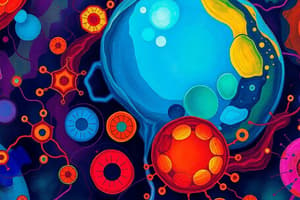Podcast
Questions and Answers
Which of the following cell types contains a nucleus?
Which of the following cell types contains a nucleus?
- Both A and C
- Bacterial cells
- Prokaryotic cells
- Eukaryotic cells (correct)
Cell membranes are completely permeable to all substances.
Cell membranes are completely permeable to all substances.
False (B)
What is the primary function of mitochondria in a cell?
What is the primary function of mitochondria in a cell?
Energy production
In eukaryotic cells, the ___ contains the genetic material.
In eukaryotic cells, the ___ contains the genetic material.
Match each type of microorganism with its corresponding description:
Match each type of microorganism with its corresponding description:
Which phase of the cell cycle involves DNA replication?
Which phase of the cell cycle involves DNA replication?
Meiosis results in the formation of somatic cells.
Meiosis results in the formation of somatic cells.
What type of staining technique can differentiate bacteria into two groups?
What type of staining technique can differentiate bacteria into two groups?
The gel-like substance where cellular processes occur is known as the ___.
The gel-like substance where cellular processes occur is known as the ___.
Which organelle is responsible for protein synthesis?
Which organelle is responsible for protein synthesis?
Flashcards are hidden until you start studying
Study Notes
Cell Biology
-
Definition: Study of cell structure, function, and processes.
-
Cell Types:
- Prokaryotic Cells: No nucleus, smaller, simpler (e.g., bacteria).
- Eukaryotic Cells: Nucleus present, larger, more complex (e.g., plants, animals, fungi).
-
Cell Structure:
- Cell Membrane: Semi-permeable barrier, regulates entry and exit.
- Nucleus: Contains genetic material (DNA).
- Cytoplasm: Gel-like substance where cellular processes occur.
- Organelles:
- Mitochondria: Powerhouse of the cell, energy production (ATP).
- Ribosomes: Protein synthesis.
- Endoplasmic Reticulum (ER): Rough (with ribosomes) and Smooth (lipid synthesis).
- Golgi Apparatus: Modifies, sorts, and packages proteins.
- Lysosomes: Digestive enzymes for waste processing.
- Chloroplasts: Photosynthesis in plants.
-
Cell Cycle:
- Phases: Interphase (G1, S, G2), Mitosis (prophase, metaphase, anaphase, telophase), Cytokinesis.
- Mitosis: Division of somatic cells for growth and repair.
- Meiosis: Division for gamete formation, involves two rounds of division.
Microbiology
-
Definition: Study of microorganisms, including bacteria, viruses, fungi, and protozoa.
-
Types of Microorganisms:
- Bacteria: Single-celled, prokaryotic, diverse metabolic activities; can be beneficial or pathogenic.
- Viruses: Acellular, require host cells to replicate; can cause diseases.
- Fungi: Eukaryotic, include yeast and molds; important for decomposition and medicine (e.g., penicillin).
- Protozoa: Unicellular eukaryotes, often motile; can be free-living or parasitic.
-
Microbial Growth:
- Requires nutrients, suitable temperature, pH, and moisture.
- Growth curve phases: Lag, log, stationary, and death phase.
-
Techniques in Microbiology:
- Culturing: Growing microorganisms in controlled conditions (e.g., agar plates).
- Staining: Techniques like Gram staining to differentiate bacteria.
- Microscopy: Light and electron microscopy for visualization.
-
Applications:
- Medicine: Antibiotics, vaccines, understanding pathogens.
- Industry: Fermentation, biotechnology.
- Environmental: Bioremediation, nutrient cycling.
Cell Biology
- Study focuses on the structure, function, and processes of cells.
- Prokaryotic Cells: Lack a nucleus; smaller, simpler organisms like bacteria.
- Eukaryotic Cells: Contain a nucleus; larger and more complex, including plants, animals, and fungi.
Cell Structure
- Cell Membrane: Semi-permeable; regulates the movement of substances in and out of the cell.
- Nucleus: Houses genetic material (DNA), controls cellular activities.
- Cytoplasm: Gel-like medium where biochemical processes occur.
Organelles
- Mitochondria: Known as the powerhouse of the cell; responsible for ATP energy production.
- Ribosomes: Sites of protein synthesis, can be free-floating or attached to the endoplasmic reticulum.
- Endoplasmic Reticulum (ER): Two types—Rough ER (with ribosomes for protein synthesis) and Smooth ER (involved in lipid synthesis).
- Golgi Apparatus: Responsible for modifying, sorting, and packaging proteins for secretion or delivery to other organelles.
- Lysosomes: Contain digestive enzymes that break down waste materials and cellular debris.
- Chloroplasts: Present in plant cells; sites of photosynthesis, converting sunlight into energy.
Cell Cycle
- Comprises phases: Interphase (subdivided into G1, S, G2), Mitosis (includes prophase, metaphase, anaphase, telophase), and Cytokinesis.
- Mitosis: Process of somatic cell division crucial for growth and repair of tissues.
- Meiosis: Special cell division for gamete formation; involves two rounds of division leading to genetic diversity.
Microbiology
- Field of study concerning microorganisms, including bacteria, viruses, fungi, and protozoa.
Types of Microorganisms
- Bacteria: Unicellular and prokaryotic; can exhibit beneficial or pathogenic behavior.
- Viruses: Acellular entities that require a host cell to replicate; often responsible for various diseases.
- Fungi: Eukaryotic organisms, including yeasts and molds; play significant roles in decomposition and medical applications, such as penicillin production.
- Protozoa: Unicellular eukaryotes that may be motile; can exist as free-living organisms or parasites.
Microbial Growth
- Requires specific conditions: nutrients, optimal temperature, appropriate pH, and moisture.
- Growth phases include Lag, Log, Stationary, and Death phases.
Techniques in Microbiology
- Culturing: Controlled growth of microorganisms, often on agar plates.
- Staining: Techniques like Gram staining help differentiate bacteria based on cell wall characteristics.
- Microscopy: Uses light or electron microscopy to visualize microorganisms.
Applications of Microbiology
- Medicine: Development of antibiotics and vaccines; helps understand and combat pathogens.
- Industry: Utilizes microbial processes in fermentation and biotechnology.
- Environmental: Involves bioremediation and nutrient cycling to sustain ecosystems.
Studying That Suits You
Use AI to generate personalized quizzes and flashcards to suit your learning preferences.




